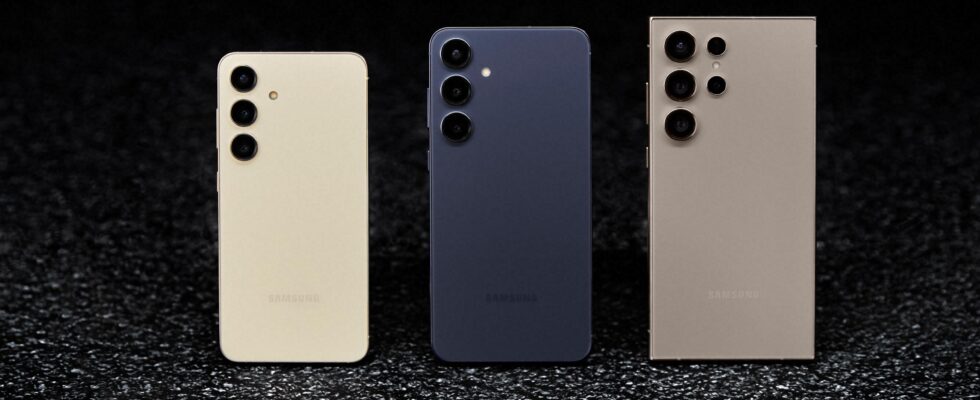The Exynos 2400 and Snapdragon 8 Gen 3 SoCs that equip the Galaxy S24 have several divisive features. It remains to determine the concrete scope of the choices made.
The 2024 vintage of Samsung Galaxy smartphones marks the return of two processors depending on the models and countries of sale: Snapdragon 8 Gen 3 in some cases, Exynos 2400 in others. These are two very high-end processors which probably offer convincing performance – however, we will have to wait for the tests to be certain. In the meantime, we review the main characteristics of these two SoCs.
Galaxy S24: the return of a two-headed range
First of all, let us point out that the Snapdragon 8 Gen 3 is of course nothing exclusive to the Galaxy S24, S24 Plus and S24 Ultra; it is intended to equip a number of high-end models in 2024. Concerning the Korean brand’s devices, the Qualcomm chip powers the Galaxy S24 Ultra everywhere in the world, but the S24 and S24+ only in Canada, the United States as well as in China. In other countries, these two editions inherit the Exynos 2400, the chip designed and manufactured by Samsung.
On the other hand, the two chips had been the subject of complete presentations by their respective designers during the last months of 2023. You can refer to them for more details, the idea here being rather to compare their characteristics main.
Exynos 2400 vs Snapdragon 8 Gen 3: 10 CPU cores versus 8
In terms of the engraving process, it is 4 nm for the two ARM processors. Samsung Foundry is responsible for manufacturing the Exynos 2400 from its 4LPP+ node. Qualcomm entrusts the production of its Snapdragon 8 Gen 3 to the Taiwanese founder TSMC via the N4P. Few people are in on the secret of the gods, but overall, Samsung’s node would be slightly less sophisticated than that of its competitor. No mistake, we remain on very accomplished engraving processes.
On paper, one of the notable differences between the Exynos 2400 and the Snapdragon 8 Gen 3 has to do with the CPU. We have an atypical 10 cores compared to a more traditional 8 cores; always with Prime, Big, Mid and Small cores.
More precisely, in the Exynos, we find a Cortex-X4 main core at 3.2 GHz; five Cortex-A720 cores, two of which operate at 2.9 GHz and three at 2.6 GHz; quad Cortex-A520 cores at 2 GHz.
The Snapdragon 8 Gen 3 also uses a Cortex-X4 CPU core, but clocked at 3.3 GHz. The five Cortex-A720 cores are also there, but in 3 + 2 this time, with a frequency of 3.15 GHz for the first and 2.96 GHz for the pair. Finally, the Cortex-A520s are only two within the Qualcomm chip, but go up to 2.27 GHz.
Anyway, to keep it short: the Snapdragon 8 Gen 3 has fewer CPU cores than its rival, but its own are faster. Both chips support UFS 4.0 storage and LPDDR5X.
GPU, NPU and Connectivity
For the GPU part, the Snapdragon 8 Gen 3 features the Adreno 750, whose specifications are, as is often the case, very poorly documented. But clearly, it is one (if not the) of the most efficient GPUs of the moment for smartphones. The Exynos 2400 benefits from the know-how of AMD, which is a partner of Samsung. It thus uses the latest graphics architecture of the Reds, RDNA 3.
Both GPUs support VRR (Variable Rate Shading) as well as HDR and offer hardware acceleration of ray tracing. The QHD+ definition at 144 Hz is within the reach of both solutions, but the Snapdragon caps at 60 Hz in 4K, compared to 120 Hz for the Exynos.
Another key engine of SoCs is the NPU (Neural Process Units). Its role consists of processing functionalities linked to artificial intelligence, both in terms of photography and generative AI. As with GPUs, there is little evidence. Let’s just point out the performance index provided by Qualcomm: 45 TOPS. Samsung hasn’t shipped one for the Exynos 2400, but Dr. Ian Cutress suggests 44 TOPS INT8.
Finally, in terms of connectivity, the maximum download speed mentioned by Qualcomm for its Snapdragon X75 5G modem is 10 Gbit/s, compared to 12.1 Gbit/s at Samsung. The American company’s chip has the advantage of offering Wi-Fi 7 as well as Bluetooth 5.4, while the Exynos 2400 is limited to Wi-Fi 6E and Bluetooth 5.3.
Exynos 2400 vs Snapdragon 8 Gen 3: which one wins?
On paper, it is difficult to determine a winner. In any case, the exercise would make little sense. The tests which will undoubtedly be published at the time of the release of the smartphones (January 31) will make it possible to gauge the performance of the two chips in the same ring, that of the S24.
Yesterday, however, we saw the GPU of the Exynos 2400 crush that of the Exynos 2200, while being sharply corrected by the Adreno 750 of the Snapdragon.
For the CPU component, a first review offered on the Khôi Ngọng YouTube channel also gives an advantage, but moderate, to the Snapdragon. In AnTuTu, it scores 1,819,945 points versus 1,699,940 points, a difference of about 7.1%.
The processor market is among the most dynamic in the world of tech, but also the most extensive. AMD/Intel references are numerous and often updated. It’s not easy to find your way in such a jungle: our selection should help you.
Read more
Source : Beebom

2